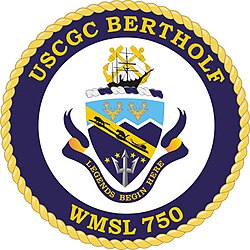 USCGC Bertholf (WMSL-750) | |
| History | |
|---|---|
| Namesake | Commodore Ellsworth P. Bertholf, USCG |
| Ordered | January 2001 |
| Builder | Northrop Grumman Ship Systems, Pascagoula, Mississippi, U.S. |
| Cost | US$641 million [1] |
| Laid down | March 29, 2005 |
| Launched | September 29, 2006 |
| Christened | November 11, 2006 |
| Commissioned | August 4, 2008 |
| Homeport | Integrated Support Command Alameda |
| Identification |
|
| Motto | "Legends Begin Here" |
| Status | In active service |
| Badge |  |
| General characteristics | |
| Displacement | 4500 LT |
| Length | 418 feet (127 meters) |
| Beam | 54 feet (16 meters) |
| Draft | 22.5 feet (6.9 meters) |
| Propulsion |
|
| Speed | 28+ knots |
| Range | 12,000 nm |
| Complement | 113 (14 officers + 99 enlisted) and can carry up to 167 depending on mission [3] |
| Sensors & processing systems |
|
| Electronic warfare & decoys | |
| Armament |
|
| Armor | Ballistic protection for main gun |
| Aircraft carried | 2 x MH-65C Dolphin MCH, or 4 x VUAV or 1 x MH-65C Dolphin MCH and 2 x VUAV |
| Aviation facilities | 50-by-80-foot (15 m × 24 m) flight deck, hangar for all aircraft |
USCGC Bertholf (WMSL-750) is the first Legend-class maritime security cutter of the United States Coast Guard. She is named for Commodore Ellsworth P. Bertholf, fourth commandant of both the Revenue Cutter Service and Coast Guard.
Contents
In 2005, construction began at Northrop Grumman's Ship Systems Ingalls Shipyard in Pascagoula, Mississippi. She was launched on September 29, 2006, [4] christened November 11, 2006, [5] and commissioned on August 4, 2008. The cutter's home port is Alameda, California. Bertholf was the first to fire the Bofors 57 mm gun aboard a U.S. vessel on 11 February 2008. [6]



